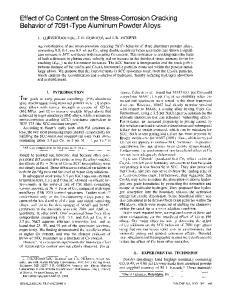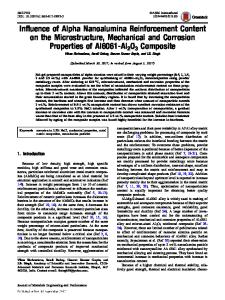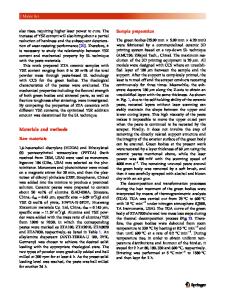Influence of Zn Content on Microstructures, Mechanical Properties and Stress Corrosion Behavior of AA5083 Aluminum Alloy
- PDF / 2,898,233 Bytes
- 10 Pages / 595.276 x 790.866 pts Page_size
- 96 Downloads / 446 Views
Influence of Zn Content on Microstructures, Mechanical Properties and Stress Corrosion Behavior of AA5083 Aluminum Alloy Zhixiong Zhu1 · Xingxu Jiang1 · Gang Wei1 · Xiaogang Fang1 · Zhihong Zhong1 · Kuijing Song1 · Jian Han2 · Zhengyi Jiang3 Received: 18 November 2019 / Revised: 14 April 2020 © The Chinese Society for Metals (CSM) and Springer-Verlag GmbH Germany, part of Springer Nature 2020
Abstract To enhance the stress corrosion cracking (SCC) resistance, Zn was utilized as an alloy element to add in the AA5083 aluminum alloys. The effects of Zn content on the microstructures, mechanical properties and SCC resistance were systematically evaluated. The results demonstrate that in the studied range adding Zn can significantly improve the SCC resistance of the AA5083 alloys. This is related to the relatively low amount of continuous β ( Al3Mg2) phase along grain boundary and the formation of Zn-containing phase such as Al5Mg11Zn4 phase. Based on the results, the optimal Zn content with respect to SCC resistance is approximately 0.50 wt.%. Further increasing Zn content results in coarse precipitates discontinuously distributed along grain boundaries. Keywords AA5083 aluminum alloy · Slow strain rate test · Precipitation · Stress corrosion cracking
1 Introduction The AA5083 aluminum alloy has been widely used as structural material in the industry of marine, aerospace, shipbuilding and automobile, due to its desirable properties such as excellent formability, corrosion resistance and weldability and high strength-to-weight ratio [1, 2]. It is known that AA5083 alloy cannot be strengthened through heat treatment [3]. The main strengthening mechanisms in AA5083 alloy are solution strengthening and strain hardening deriving from Mg element [4].
Available online at http://link.springer.com/journal/40195. * Zhixiong Zhu [email protected] * Zhengyi Jiang [email protected] 1
School of Materials Science and Engineering, Hefei University of Technology, Hefei 230009, China
2
School of Materials Science and Engineering, Tianjin University of Technology, Tianjin 300384, China
3
School of Mechanical Engineering and Automation, University of Science and Technology Liaoning, Anshan 114051, China
However, the relatively high Mg content, i.e., 3.5–5 wt.% or even higher, and the resultant supersaturated of Mg in the AA5083 alloy lead to the formation of β ( Al3Mg2) phase when it is exposed to an elevated high temperature for a long time [5]. This type of phase preferably precipitates out at the grain boundaries and continuously distributes along the boundaries. The β phase has a more negative potential and is anodic to α-Al matrix, which can be easily corroded in saline environment [6]. Hence, the AA5083 alloy is sensitive to the stress corrosion cracking (SCC) in some occasion. This issue will undoubtedly restrict its application, especially in the corrosive environment. Over the past decades, numerous attempts have been made on AA5083 alloy to improve the strength and corrosion resistance through adding m
Data Loading...











